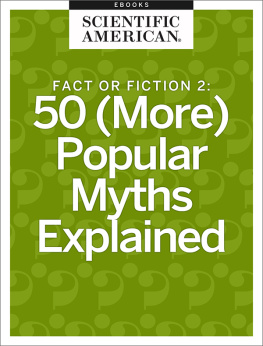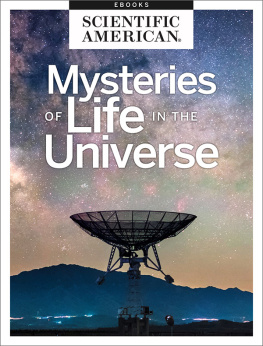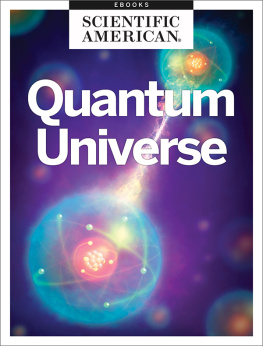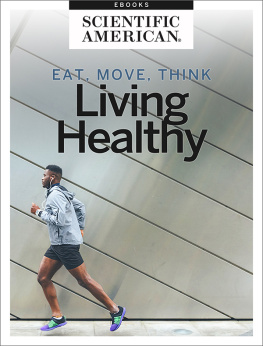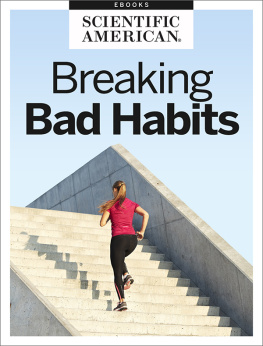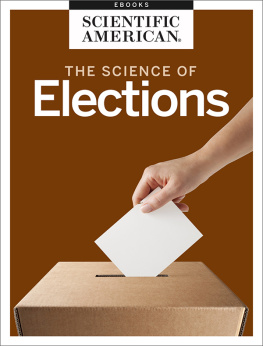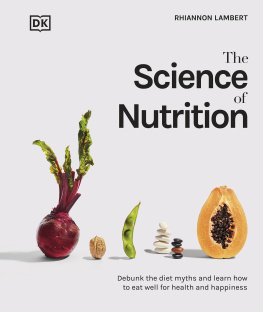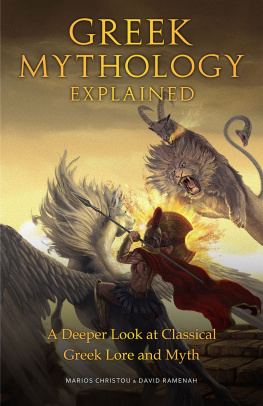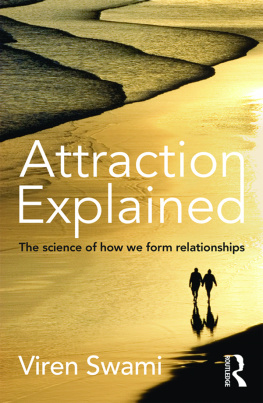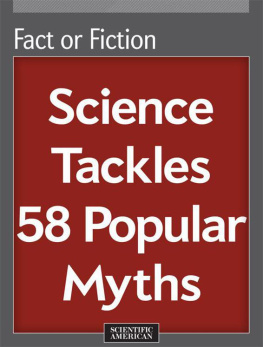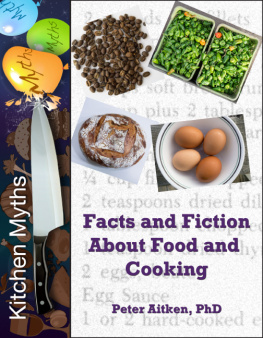FACT OR FICTION 2:
50 (More) Popular Myths Explained
From the Editors of Scientific American
Cover Image:
Letters to the Editor
Scientific American
One New York Plaza
Suite 4500
New York, NY 10004-1562
or editors@sciam.com
Copyright 2017 Scientific American, a division of Nature America, Inc.
Scientific American is a registered trademark of Nature America, Inc.
All rights reserved.
Published by Scientific American
www.scientificamerican.com
ISBN: 978-1-4668-5905-0


FACT OR FICTION 2:
50 (More) Popular Myths Explained
From the Editors of Scientific American
Table of Contents
Introduction
by Karin Tucker
Section 1
1.1
by Melinda Wenner Moyer
1.2
by the Editors
1.3
by Janeen Interlandi
1.4
by Karen Blankfeld Schultz
1.5
by Karen Schrock
1.6
by Roni Jacobson
1.7
by Carol S. Dweck
1.8
by Hal Arkowitz, Scott O. Lilienfeld
1.9
by Gary Stix
1.10
by Daphne Bavelier and C. Shawn Green
Section 2
2.1
by Dina Fine Maron
2.2
by Christine Gorman
2.3
by Annie Sneed
2.4
by Julia Calderone
2.5
by Larry Greenemeier
2.6
By Mark Fischetti
Section 3
3.1
by Charlotte N. Markey
3.2
by Dina Fine Maron
3.3
by Julia Calderone and Ben Fogelson
3.4
by Dina Fine Maron
3.5
by Christie Nicholson
3.6
by Annie Sneed
3.7
by Dina Fine Maron
3.8
by Dina Fine Maron
3.9
by Annie Sneed
3.10
by Melinda Wenner
3.11
by Dina Fine Maron
3.12
by Dina Fine Maron
3.13
by Anne Casselman
Section 4
4.1
by Mara Hvistendahl
4.2
by David Biello
4.3
by David Biello
4.4
by Lee Billings
4.5
by David Biello
4.6
by David Biello
Section 5
5.1
by Lee Billings
5.2
by Lee Billings
5.3
by Anna Gosline
Section 6
6.1
by Larry Greenemeier
6.2
by Larry Greenemeier
6.3
by Larry Greenemeier
6.4
by Elena Malykhina
6.5
by Clara Moskowitz
6.6
by Alison Snyder
Section 7
7.1
by Mark Fischetti
7.2
by Anne Casselman
7.3
by Clara Moskowitz
7.4
by JR Minkel
7.5
by Rachel Dvoskin
7.6
by The Editors
Strange But True Or Truly Strange?
The great enemy of the truth is very often not the lie, deliberate, contrived and dishonest, but the myth, persistent, persuasive and unrealistic. John F. Kennedy
Have you ever heard of the 5-Second Rule? Thats the axiom that says food that has fallen on the floor is safe to eat if it has been picked up within 5 seconds. Or what about how you should feed a cold, starve a fever to cure your ailments? Or how shaving hair causes it to grow back thicker and coarser? These rules, home remedies and myths guide many of the decisions we make on a daily basis. But are they scientifically true or accurate? With this eBook, Fact or Fiction 2: 50 (More) Popular Myths Explained,were back with more articles from Scientific Americans Fact or Fiction series that delve into the popular myths that we hear so often that we take them as truth.
The first section explores myths regarding the mind and brain falsehoods that attempt to explain the psychological and neurological events we experience. We start with Is Pregnancy Brain a Myth by Melinda Wenner Moyer. In this selection, Moyer explores if science can back up the claim that women are less mentally sharp during pregnancy. This section continues with explorations into the effectiveness of acupuncture, the veracity of an Aha! moment and how divorce really affects children.
We then follow this up with sections covering Food and Health and Body. Here we investigate topics that include whether your vision really can be enhanced by eating carrots and the truth behind vaccines. Sections on Sustainability, Space/Astrophysics, and Technology further survey issues regarding global warming, dark matter and our possible technological vulnerabilities to hackers.
We finish up this collection with a Miscellany section. Even though these articles arent easily categorized that doesnt mean they are any less interesting and thought provoking. Here we look at topics such as the reality of the law of conservation of energy and if any form of capital punishment really can be compassionate.
As you can see, myths and axioms pervade almost every aspect of our lives. Luckily, truth seekers like the editors at Scientific American are here to debunk these myths, one Fact or Fiction article at a time.
--Karin Tucker
Executive Editor
"Pregnancy Brain" Is a Myth
by Melinda Wenner Moyer
As many as four out of every five pregnant women say thatthey suffer from pregnancy brain deficits in memory andcognitive ability thatarise during pregnancy,making womenmore forgetfuland slow-witted. Yetstudies on the phenomenonhave generallynot supportedthese claims: althoughsome havefound evidence ofproblems on certaintypes of tasks, others,including arecent paper publishedby researchersin Utah, havefound no signs ofcognitive problems at all. Some experts believe that pregnancybrain and its postnatal cousin, baby brain, couldlargely be a product of confirmation bias: pregnant womenand new moms expect to experience brain fog and thereforebelieve they are actually affected. Others argue that themental symptoms might simply be too difficult to confirm ina laboratory setting.
In the most recent study, researchers at Brigham YoungUniversity gave cognitive and neuropsychological tests to21 women in their third trimester of pregnancy and then testedthem again six months after they gave birth. They administeredthe same tests at similar intervals to 21 women whohad never been pregnant. They found no differences betweenthe groups no matter when they were tested, including beforeand after giving birth. These findings mesh with those from a2003 study, which found that pregnant women did not scoredifferently from nonpregnant women on tests of verbal memory,divided attention and focused attention.
There is variety in the results, but overall most studiessuggest there are few to no memory impairments associatedwith pregnancy, says Michael Larson, a psychologist atBrigham Young and a co-author of the recent paper. Hethinks the reason the myth persists may be that womenselectively look for evidence that supports the cultural expectation.For example, when a pregnant woman loses her carkeys, she might blame pregnancy brainwithout recallingthe times she lost her car keys before she was pregnant.
Joanna Workman, a psychologist at the University atAlbany, agrees that confirmation bias may play a role, butshe says there is another possibility, too. In a 2011 study,a team at the University of British Columbia found thatalthough pregnant women did not display any problems oncognitive tests given in a lab, they were less likely than nonpregnantwomen to remember to call the lab when asked andto return a questionnaire on time. Its possible that lab-basedmeasures do not reveal differences, because labs aretypically quiet environments with minimal distractions, in contrastwith everyday life, she says.

